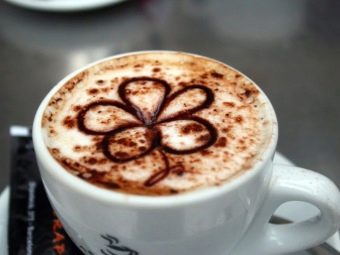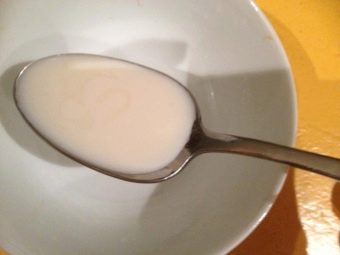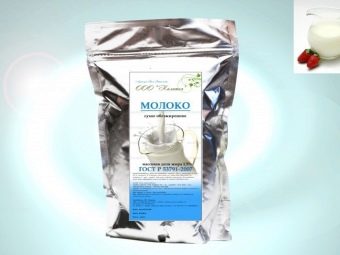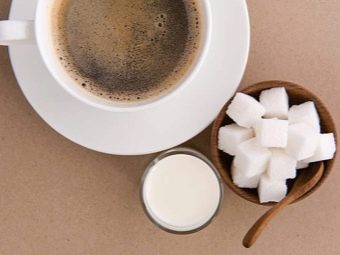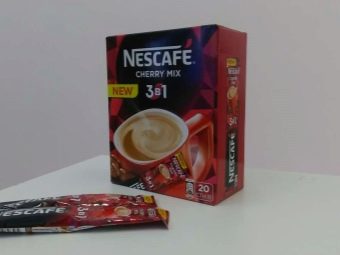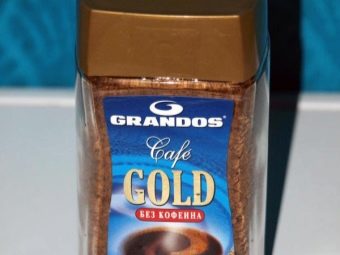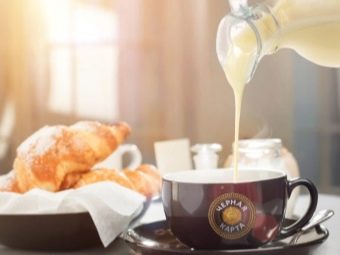Coffee with milk: calorie content and composition of the drink
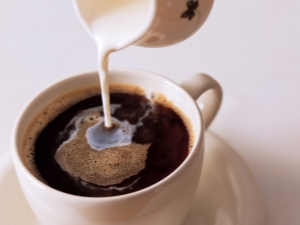
One of the most popular drinks for coffee is milk. It is usually added to soften the bitterness and strength of the coffee.However, it is important to understand that the caloric content of the drink in this case increases.
The chemical composition of the grains
100 grams of coffee beans contain up to 5 mg of calcium, 2 mg of iron. In addition, it contains nitrogen, phosphorus and sodium, as well as B vitamins and vitamin PP. The latter has a positive effect on the vascular system, strengthening the vascular walls and preventing the formation of cholesterol "plaques" on their inner surface.
Coffee beans contain up to 30 organic, and both common (apple, coffee), and quite rare (chlorogenic). Grains are rich in caffeine, which are here in the range of 0.65 - 2.7%. In the process of roasting, the caffeine content rises to at least 1.3%. In the soluble version, the caffeine content is even higher and can reach 5%.
How many calories?
Some people mistakenly consider coffee as a high-calorie drink. However, black coffee without sugar, milk and additives has a low energy value, so it can be included in the diet. Moreover, the caffeine in the grains has a slight fat burning effect.
Milk added to coffee increases its caloric content. At the same time indicators of fat content of a dairy additive matter. The lower they are, the less calories. So, with milk fat content of 1.5%, 45 kcal per 100 ml or 9 kcal per 1 teaspoon in it. With a fat content of 2.5%, these figures increase to 55 kcal and 11 kcal, respectively. Milk fat content of 3.2% indicates that 100 ml contains 61 kcal, and a teaspoon - 12 kcal.
In a tablespoon can hold about 20 ml of milk, this amount is usually added to a small cup of coffee. When it comes to a larger glass, it is optimal for many to add 50 ml of milk (about 2.5 tablespoons). In this case, the caloric content for 50 ml of milk with fat content of 1.5% is 22 kcal, for milk with fat content of 2.5%, 26 kcal, with fat content of 3.2 to 29 kcal.
If you use homemade cow's milk, which is quite fat, then in 100 ml - 64 kcal, in 20 ml - 13 kcal, in 50 ml - 32 kcal.
The lowest energy value has skim milk (this includes those whose fat content is less than 0.5%). Only 35 kcal is contained in 100 ml and 7 kcal in a teaspoon. However, in its composition, skim milk cannot be considered “empty” - it contains vitamins D, A, C, PP, as well as calcium, potassium, trace elements, amino acids and enzymes important for the body.
Those people whose body does not absorb milk protein, replace animal milk with vegetable. The most popular and affordable is considered to be soy. Drink with soy milk has a caloric content of 8 to 24 kcal, depending on the type of milk and its quantity. In 100 ml of 0.1% soy milk contains 64 kcal, in 20 ml - 6 kcal, in 50 ml - 14 kcal, respectively.
With an increase in the fat content of soy milk to 0.6%, the caloric content increases to 43/9/22 kcal per 100/20/50 ml.
Coconut milk demonstrates even greater nutritional value - in 100 ml of the product it is 180 kcal. Accordingly, 90 kcal for 50 ml and 36 kcal for 20 ml.
If we talk about dry coconut milk, then its energy value reaches 690 kcal per 100 g! Definitely, this product can not be called dietary and its addition to coffee is extremely undesirable for those who have the problem of excess weight.
Some people, for various reasons, refuse to use “liquid” vegetable or animal milk in favor of more convenient dry milk. It, in turn, is whole and fat-free, although in both cases it is a question of high calorie content. Per 100 g of dried whole milk there are 476 kcal, on skimmed dry milk - 350 kcal. 20 mg of the first contains 95 kcal, the second - 70 kcal. Finally, the energy value of whole dried milk is 238 kcal, skimmed - 175 kcal.
To calculate the caloric content of coffee with milk, add the number of calories per serving of coffee and calories of milk added to the drink. This takes into account its volume and fat content.
Natural
The nutritional value of natural or grain ground coffee is rather low - per 100 g of dry product, 201 kcal. If we are talking about a teaspoon of ground natural coffee (about 3-5 g), then the caloric content ranges from 6 to 10 kilocalories.
A cup of black natural coffee (200 ml) is 2 kcal. If you add 50 ml of milk and a teaspoon of sugar to the same amount of drink, then the caloric content will increase to 60 kcal, if 2 spoons of sweetener - to 85 kcal.
Calorie also depends on the degree of roasting of grains. Green coffee beans have a caloric content of 331 per 100 g of product, black ground coffee contains 200.6 kcal for the same amount. It turns out that in a black ground coffee per 10 g (approximate amount per cup) - 20.06 kcal.
Soluble
Instant coffee is more nutritious than natural coffee. This is due to the fact that in its composition of natural grains no more than 15-20%, the rest is thickeners, stabilizers and other additives. The percentage of caffeine in it is also higher. There are 94 kilocalories per 100 g of coffee. It is much more convenient to measure the caloric value of spoons - in the tea contains 12 kcal, in the dining room - 34 kcal.
If we are talking about instant coffee in small bags (one-off), then most of them are a mixture of "3 in 1" and contains sugar. When adding a glass of water (200 ml), an average calorie drink is 70 kcal.
A similar product without sugar (black instant coffee in a bag) has a much lower caloric content - about 17-18 kcal.
By the way, if you are on a diet, it is much better to drink just such a drink, and not an analogue of "3 in 1".
If necessary, it can be sweetened, while the calorie content will still be less nutritional "3 in 1". So, a teaspoon of granulated sugar (about 6 g) contains only 24 kcal, and a cube of refined sugar (weighing 5 g) - 20 kcal.
As for the soluble drink in cans, the caloric content of 1 teaspoon is about 10 g and may vary depending on the brand. So, there are less high-calorie types of instant coffee, for example, in 1 teaspoon of Nescafe contains about 4-5 kilocalories, while in the same amount of coffee from the Tchibo brand this figure can reach 20!
Exact data is always indicated by the manufacturer on the packaging. To calculate the caloric content of the finished drink, it is important to add also the caloric content of milk and sugar, if you put it. For example, when brewing 2 teaspoons of Carte Noire coffee, you get a drink of 20 kcal (10 kcal in each spoon). If you add to it 50 ml of milk with a fat content of 2.5%, the calorie content will increase to 46 kcal.
There is another kind of instant product - decaffeinated coffee. Kalorazh of such granules - from 0 to 1 kcal, so when calculating it can be completely ignored, counting only the amount and energy value of milk additives and sweetener.
Summing up, we can say that the most harmless for those who consider the number of calories consumed is grain. The standard portion has about 7-10 kcal. The most dangerous - drink "3 in 1", a portion of which can consist of up to 105 kcal. "Intermediate" indicator shows instant coffee, the caloric content of which per serving in 200 ml is approximately equal to 20 kcal.
Volumes
Calorie content depends not only on the type of coffee, but also the volume of a cup of coffee with milk, the number of spoons of sugar that is added to the drink.
A standard cup of coffee is 200 ml. At the same time it is better that most of it was coffee. Milk should be introduced into the drink using a teaspoon or tablespoon. If you increase the volume of coffee, choosing a larger mug, follow the same rule - a larger volume should take a drink with a lower calorie content.
It is important to observe the proportions of coffee preparation - for a 200 ml cup, 7 g of ground beans or 1 and 2 teaspoons of instant coffee are taken. If you increase the amount of coffee, the drink will turn out too strong, which will cause the desire to add more milk or add sweetener.
Caution should be taken with coffee drinks with the addition of foamed milk and cream, since milk is usually taken in equal or close to it quantities of coffee, which in itself increases the energy value.
In addition, to obtain a beautiful "cap" apply fatty milk or cream, as well as sugar and syrups are introduced. Finally, these drinks (cappuccino, mocha, etc.) are usually served in tall glasses with volumes ranging from 180 to 300-400 ml. It also contributes to the fact that for one “coffee drinking” you will receive at least 200 kcal.
Various additives
The combination of coffee and milk is the basis for the preparation of a large number of drinks. They can include various additives and sweeteners, which is why their energy value varies.
For example, cappuccino is an espresso with the addition of milk, part of which is pre-foamed. The drink is usually served in 180 ml glasses, adding sugar. This portion has 210 kcal, and 100 ml of the drink contains 120 kcal.
Another type of coffee with milk - latte. It is a double espresso with milk, which is processed by steam. Served in high glasses of 220 ml. Its energy value is 180-220 kcal.
One of the most high-calorie coffee drinks with milk is mocha or mokkachino. In addition to strong espresso and milk, it includes hot chocolate and cream, and in addition, it can be decorated with syrups, chocolate chips. Nutritional value per 100 ml of drink - 250 kcal.
The leader in calories, perhaps, can be called frappuccino - a cold coffee drink made from espresso and milk with the addition of 1 tablespoon of sugar and ice. A portion of frappuccino is 460 ml, and the amount of calories in this amount of drink is 400.
Trying similar drinks in coffee shops and restaurants, it is not always possible to compare their caloric content. In this case, it should be borne in mind that the larger and more magnificent the milk cap on coffee, the more nutritious it turns out. This is due to the fact that to obtain a fluffy foam using milk of higher fat content (not less than 3-3.5%), since whipping less fatty counterparts, the foam turns gray and quickly settles.
This suggests that in most cases, the latte is more nutritious than cappuccino. It is important that in different networks the caloric content of the same drink of the same volume may vary. For example, a 100-ml serving latte in “Chocolate” contains 35 kcal, and the same 300 ml drink in McDonalds - 123 kcal. It is easy to calculate that by drinking the same 300 ml in "Chocolate Girl", you get a little less calories - 105 kcal.
Sugar is added to almost all coffee drinks. Depending on the type, it has a caloric content in the range of 20-40 kcal. If we are talking about a teaspoon of white sugar, then its caloric content is 24 kcal. The cafe is often served with a drink along with small paper bags filled with sugar. Its volume is 6 mg, which corresponds to 1 teaspoon.
Brown or cane sugar has almost the same caloric content as the usual white - 25 kcal per 1 teaspoon. Sugar includes from 20 to 40 kcal, depending on its size.
Instead of sugar, some prefer to drink coffee with honey. Other things being equal, such a drink will be more high-calorie than with sugar. In a teaspoon of honey about 30-44 kcal.
Sometimes instead of milk in a cereal or instant drink add condensed milk. The taste of the drink becomes softer, and he himself is noticeably sweeter. The average caloric value is 300 kcal per 100 g of product. Up to 12 g of condensed milk is placed in a teaspoon, therefore the nutritional value of coffee with condensed milk (with each teaspoon) increases by 36 kcal. There is also condensed milk without sugar, the energy value of which is 2.5 times less than usual.
Cream - another supplement, which is put in the coffee instead, and sometimes with milk. It should be understood that they significantly increase the nutritional value of the drink due to its higher fat content. So, a standard bag of cream (10 ml) contains about 30 kcal, and a similar bag of dry cream - 45 kcal. When it comes to cream 35% fat, then there are 340 kcal per 100 ml. The same cream is used for whipping when forming a cream "cap" on coffee.
Can I use for weight loss?
Coffee itself, as already mentioned, has a small amount of calories, and drunk in the morning, it invigorates, improves concentration and energizes. For people with low blood pressure, a morning serving of coffee allows you to feel better all day long.
It is important to choose a suitable coffee so that its calorie content easily fits into the daily calorie. The least high-calorie coffee is considered to be coffee. That he should be given preference. It is even better to buy grains and grind them yourself immediately before use. When buying ready-made ground coffee there is a possibility of the presence in the package of other components that increase caloric content.
Dieters, it is better to abandon the drinks "3 in 1", they contain too many calories and sugar. The latter, in turn, provokes dangerous insulin spikes in the body.
With a decrease in milk fat content by 0.5%, its energy value decreases by almost 2 times. This should be used if you are on a diet, but you cannot refuse coffee with milk. In this case, the best choice would be skimmed milk, which at the same time contains the necessary nutritional elements.
Of course, it is better to reduce the volume of milk to 1 teaspoon or tablespoon. If you add milk to mitigate the bitterness of coffee, then it is more logical to cook it from natural Arabica beans. The drink will be less strong and bitter, so you can add less milk. When adding Robusta bitterness increases, so I want to add more milk.
Again, when using natural grains for brewing coffee, you can put in a drink more fatty milk or its skimmed drink in a larger volume. When you brew instant coffee, it exhibits greater saturation, so adding milk should be moderate.
Care should be taken to choose coffee drinks in coffee shops and cafes, because when it comes to coffee with milk, the menu is replete with attractive descriptions and photos. It is useful to preliminarily examine the caloric content of foods that must be present in the menu of a person in the form of breakfasts, lunches and dinners.
As a rule, a large portion of cappuccino or latte in its caloric content can be compared with afternoon tea or make up half a lunch ration. However, it will not bring the same benefits to the body and will only give a short feeling of fullness. Moreover, due to a sharp jump in blood sugar, after a short time, you will again feel the desire to eat something sweet.
The most correct method of drinking coffee with milk on a diet - write it in your daily diet. For example, if you drink instant coffee with 50 ml of milk with a 2.5% fat content, this is about 46 kcal. Relatively little. If you drink it 3-4 times a day, then the caloric content will be 138-184 kcal. This “pulls” on a small snack, so be sure to include such a coffee break in the daily diet.
It is important that such a meal plan for each day is highly disciplined and saves from the temptation to eat or drink something unsuitable under the influence of emotions or a sudden feeling of hunger.
Modern nutritionists recommend another option for drinking coffee with milk during a diet. This option is suitable for those who keep a fairly strict diet and do not allow for a week of flour, sweet, fat. However, once a week it is fashionable to arrange chitmil, that is, the use of one "prohibited" product. As such, it is quite possible to afford a large portion of cappuccino or mocha, generously poured with syrup and decorated with chocolate chips.
Chitmil allows you to avoid disruptions, contributes to the dietary process the effect of competition with yourself, and also helps to overcome the "plateau" when the weight, despite proper nutrition, does not decrease.
Nutritionists say that it is better to eat a small amount of “forbidden” products in the morning. The same rule can be attributed to the use of sweet coffee with milk. It is better to drink it in the morning, since you will still have a whole day to burn calories.
The most harmful can be called coffee, which is drunk by most office workers. We are talking about soluble drinks or 3-in-1 sachets and cream in tablet-packs, as well as dry analogues. Each of these components is high in calories by itself, and when mixing them and adding sugar, this indicator can reach enormous values.
If there is an opportunity, it is better for the office to purchase a coffee machine that will be “refueled” with ground coffee or special coffee capsules also based on natural grains.
In some cases, experts recommend coffee with milk to dieters. First of all it concerns those who can not drink a drink without sugar. If you compare the caloric content of the latter and the nutritional value of milk, the latter will be less caloric and will help eliminate bitterness and soften the drink.
Moreover, unlike sugar, which does not benefit the body, milk contains calcium. The latter, as is well known, is washed out when consuming caffeinated beverages. Thus, milk in coffee performs a double function - it eliminates sugar, reducing the bitterness of coffee, and increases the benefit of the latter.
Interestingly, there are even diets that imply drinking coffee with milk. The most popular are several of them.
The first is designed for 2 weeks. According to this meal plan, you need to drink a small cup of coffee with milk at breakfast. For lunch, you should choose a portion of vegetable salad and 100-150 g of lean meat or fish, and 20 minutes after the meal, drink a cup of coffee again with milk added. For dinner, you can cook vegetables (fresh or stewed, baked) and all the same drink.
The second diet is designed for a week and generally repeats the first, but demonstrates an increased amount of protein. For lunch, in addition to meat (preferably chicken or turkey), eggs are recommended, for dinner - cottage cheese. As a drink, 3 times a day, coffee with milk is offered. Reviews allow us to conclude that thanks to these diets can throw up to 5 kg. In this case, there is no breakdown for a sweet, because coffee with milk in this case acts as a dessert.
Coffee with milk can be drunk instead of a small snack - for example, a second breakfast or an afternoon snack. So you will be able to satisfy the feeling of hunger with a small intake of calories. At the same time, you can choose fatter types of milk or even treat yourself to a small portion of cappuccino or latte.
Coffee with milk can be drunk after eating meat or fish, as the grain contained in the beans (note only in natural coffee beans) chlorogenic acid helps break down protein, which contributes to better digestion.
Coffee with milk can be drunk before workouts, because it gives a feeling of cheerfulness, increases muscle endurance. This will allow you to achieve maximum results with active physical exertion.
To learn how to make coffee with milk in a coffee machine, see the video below.

